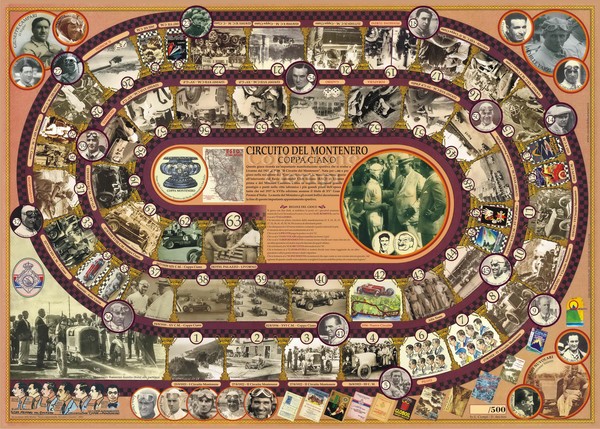
XVIII° CIRCUITO DEL MONTENERO
COPPA CIANO

|
||
| Istituto luce |

|
XVIII° CIRCUITO DEL MONTENERO
|

|
||
| Istituto luce |
| Introduzione | Articoli | Foto | Classifica e piloti |
Percorso | Pubblicità Pubblicazioni |
Montenero Home |
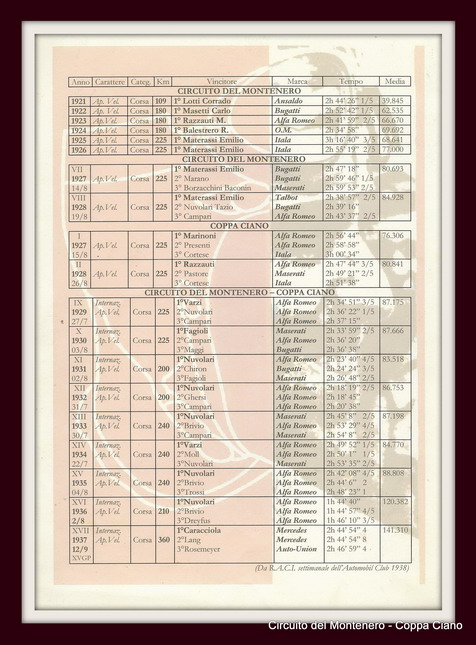
|
1938 - 7 agosto Percorso: Rotonda d’Ardenza Mare - Via della Torre - Ardenza Terra - Via del Littorale - Via Aurelia - Via dei Bagni - Viale Vittorio Emanuele - Rotonda d’Ardenza - (lunghezza: 5,875 km). “XVIII Coppa Ciano” Formula 1 4,5 litri asp. 3,0 litri comp. (40 giri - 235 km) 1) LANG Hermann, su Mercedes) 1h. 40’.35”.1/5 (media 138,388 km/h); 2) FARINA Giuseppe, su Alfa Romeo, in 1h. 41’.23”.1/5; 3) BIONDETTI Clemente/WIMILLE J.Pierre, su Alfa Romeo, a un giro; 4) BELMONDO Vittorio, su Alfa Romeo, a due giri; 5) DREYFUS René, su Delahaye a tre giri. Giro più veloce il 31° di von Brauchitsch Manfred ed il 32° di Lang Hermann in 2’.25”.2/5 a 143,603 Km/h. Ritirati: ZEHENDER Goffredo (Maserati) al 2° giro; COMOTTI Gianfranco (Delahaye) al 7° giro; TEAGNO Edoardo (Maserati) al 12°giro; TROSSI Carlo Felice (Maserati) al 16° giro; CARACCIOLA Rudolph (Mercedes) al 26° giro. N.B.: Manfred Von Brauchitsch (Mercedes) era transitato primo al traguardo in 1h 39’56”2/5 ma venne squalificato perché dopo un testa coda nei pressi del traguardo la sua vettura era stata rimessa in pista dal pubblico, azione non consentita dal regolamento delle gare internazionali. Vetturette 1500 cmc (25 giri - 145 km) 1) VILLORESI Emilio, su Alfa Romeo,in 1h.05’.21”3/5 (media 133,108 km/h); 2) BIONDETTI Clemente, su Alfa Romeo, in 1h. 05’.23”.4/5; 3) MARAZZA Aldo, su Maserati, in 1h.06’.22”.1/5; 4) CORTESE Franco, su Maserati, in 1h.06’.42”.4/5; 5) BARBIERI Ferdinando, su Macerati, a un giro; 6) SEVERI Francesco, su Alfa Romeo, a due giri. 7) CORSI Secondo, su Maserati, in a quattro giri. Giro più veloce il 13° di Villoresi Emilio in 2’.21”. 2/5 a 137,912 km/h Ritirati: PELASSA Giorgio (Maserati) al 5° giro; TEAGNO Edoardo (Maserati) all’8° giro; MORELLI Angelo (Maserati) al 9° giro; PIETSCH Paul (Maserati) al 19° giro; BREZZI Andrea(Maserati) al 20° giro. (Da: Maurizio Mazzoni: “Lampi sul Tirreno”, Firenze 2006) |
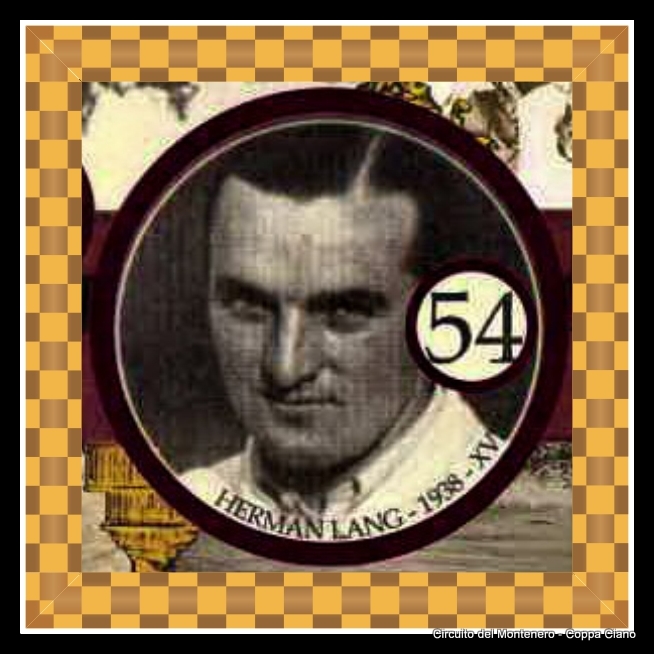
|
|
|
COPPA CIANO Livorno (Italy), 7 August 1938 40 laps x 5.8 km (3.6 mi) = 232.0 km (144.2 mi) STARTERS: N°42 Vittorio Belmondo, (R. Balestrero) Alfa Romeo Tipo 308 N°44 Rudolf Caracciola, (Daimler-Benz AG) Mercedes-Benz W154 N°46 Hermann Lang, (Daimler-Benz AG) Mercedes-Benz W154 N°48 René Dreyfus, (Ecurie Bleue) Delahaye 145 N°50 Giuseppe Farina, (Alfa Corse) Alfa Romeo Tipo 312 N°52 Goffredo Zehender, (Officine A. Maserati) Maserati 8CTF N°54 Manfred von Brauchitsch, (Daimler-Benz AG) Mercedes-Benz W154 N°56 Carlo Felice Trossi, (Officine A. Maserati) Maserati 8CTF N°58 Gianfranco Comotti, (Ecurie Bleue) Delahaye 145 N°60 Edoardo Teagno, (Scuderia Sabauda) Maserati 8CM N°62 Jean-Pierre Wimille, (Alfa Corse) Alfa Romeo Tipo 312 3000cc N°64 Richard Seaman, (Daimler-Benz AG) Mercedes-Benz W154 3000cc (DNA - did not appear) Von Brauchitsch's bad luck strikes again As Auto Union decided not to race Mercedes was the clear favourite. However, Trossi showed the potential of the new Maserati by taking pole position and then take the lead from Caracciola on lap 3 and hold it for four laps until mechanical trouble stuck. With new leader Caracciola having car trouble Lang took over first position and Farina second. Von Brauchitsch caught and passed Farina and then took the lead when Lang had to stop for tyres and held it to the chequered flag. However it was found that von Brauchitsch had received outside assistance during the race so he was disqualified and Lang was the eventually declared the winner. Entries After having been held as the Italian GP the year before the Coppa Cianco was back in the 1938 calendar. After their disappointing performance in Germany Auto Union decided not to enter the race. That was unfortunate for the spectators as Nuvolari had been sensational at Livorno in 1936. Mercedes-Benz was down to 3 cars after von Brauchitsch's crash in the German GP so Seaman was unable to start. Caracciola had the new experimental car with a huge saddle tank and shorter tail. Maserati was back with two of their fast 8CTF cars for Trossi and Zehender. Practice Trossi made the fastest time on each practice session to take the pole position. Caracciola was second and Lang fourth but von Brauchitsch was beaten by Farina's 12 cylinder Alfa. Grid (N°50) Farina (A. Romeo-2m.28s) (N°46) Lang (Mercedes-Benz-2m.27s) (N°44) Caracciola (Mercedes-Benz-2m.26.?s) (N°56) Trossi (Maserati -2m.26.6s) (N°52) Zehender (Maserati) (N°54) Brauchitsch (Mercedes-Benz) (N°62) Wimille (A. Romeo -2m.31s) (N°60) Teagno (Maserati) (N°48) Dreyfus (Delahaye) (N°58) Comotti (Delahaye) (N°42) Belmondo (A. Romeo) Caracciola took the start and led the field into the first corner followed by Lang, Farina and Trossi. Trossi soon showed that his pole position had been no coincident, passing Farina and Lang. Zehender retired his Maserati but the team hardly noticed that because on lap 4 Trossi took the other Maserati up into the lead and started to open up a gap to Caracciola. For four laps the spectators cheered as the Italian car pulled away from the Mercedes cars but that was too much for the Maserati engine and on lap 8 Trossi retired and it was back to normal business with Caracciola leading from Lang and von Brauchitsch, who had managed to pass Farina. While Caracciola was dominating the race in his experimental car, von Brauchitsch made several fierce attacks on Lang, who refused to give way. The two cars entered the right hander after the pits side by side. Lang had the proper line and went on while von Brauchitsch overdid it and slid into the straw bales and came trapped under them with a stalled engine. A number of excited Italian spectators rushed to his help and pushed von Brauchitsch back to continue the race one minute behind Lang. Wimille had trouble with his kidneys and he gave over his Alfa Romeo to Biondetti. Caracciola retired his car when a thick piece of rubber flew away from the right rear tire and punctured the fuel tank so fuel ran out in thick streaks. That left Lang the lead the race with Farina second. Von Brauchitsch soon passed Farina but he could do nothing to Lang, who looked to be a certain winner, but with only two laps remaining a rear tyre blew and Lang had to make an extra pit stop. Von Brauchitsch therefore took the flag as the winner but soon protests dropped in from several competitors against the fact that von Brauchitsch had been pushed back into the race by spectators. The organizers didn't want to disqualify him, as similar things had happened during the Voiturette race, but they were over-ruled by the President of the Sporting Council of the Italian Automobile club, Mr. Giuseppe Furmanik. So von Brauchitsch was out for having received outside assistance and Lang was declared the winner. Farina took a fine second place and Biondetti in Wimille's car was third to make it a great day for the Alfa Corse team. They had already won the Voiturette race. Results: DSQ(N°54) Manfred von Brauchitsch, (Daimler-Benz AG) Mercedes-Benz W154 -3000cc (40 laps) DSQ – (outside assistance); 1°(N°46) Herman Lang, (Daimler-Benz AG) Mercedes-Benz W154 -3000cc (40 laps) 1h.40m.35.2s; 2°(N°50) Giuseppe Farina, Alfa Romeo Tipo 312 -3000cc (40 laps) 1h.41m.23.2s (+ 48.0s); 3°(N°62) J.P. Wimille/C. Biondetti, Alfa Romeo Tipo 312 -3000cc (39 laps) 1h.41m.49.0s; 4°(N°42) Vittorio Belmondo, Alfa Romeo Tipo 308 -3000cc (38 laps) 1h.41m.54.0s; 5° (N°48) René Dreyfus, Ecurie Bleue Delahaye 145 -4500cc (37 laps) 1h.43m.14.0s; DNF(N°52) Goffredo Zehender, (Officine A. Maserati) Maserati 8CTF -3000cc engine; DNF(N°44) Rudolf Caracciola, (Daimler-Benz AG) Mercedes-Benz W154 -3000cc (26 laps) punctured fuel tank DNF(N°58) Gianfranco Comotti, (Ecurie Bleue) Delahaye 145 -4500cc; DNF(N°60) Edoardo Teagno, (Scuderia Sabauda) Maserati 8CM -3000cc; DNF(N°56) Carlo Felice Trossi, (Officine A. Maserati) Maserati 8CTF -3000cc (8 laps) (engine); Fastest lap: Hermann Lang & Manfred von Brauchitsch (Mercedes Benz) on lap 31 and 32 in 2m.25.4s = 143.6 km/h (89.2 mph) Winner's medium speed: 138.4 km/h (86.0 mph) Pole position lap speed: 142.4 km/h (88.5 mph) Weather: COPPA CIANO Voiturette 1500cc) Livorno (Italy), 7 August 1938 25 laps x 5.8 km (3.6 mi) = 145 km (90.1 mi) Drivers 2 Franco Cortese , Maserati 6 CM -1500cc; 4 Ettore Bianco , Maserati 4 CM -1500cc (DNA - did not appear); 6 Andrea Brezzi , Maserati 4 CM -1500cc; 8 Arialdo Ruggeri , Maserati 6 CM -1500cc; 10 Guido Barbieri , Maserati 4 CM -1500cc; 12 Angelo Marelli , Maserati 4 CM -1500cc; 14 Francesco Severi , Alfa Romeo 158 -1500cc; 16 Edoardo Teagno , Maserati 6 CM -1500cc; 18 Secondo Corsi , Maserati 4 CM -1500cc; 20 “Raph” , Maserati 6 CM -1500cc; 22 Luigi Villoresi , Maserati 6CM -1500cc; 24 Clemente Biondetti , Alfa Romeo 158 -1500cc; 26 Emilio Villoresi , Alfa Romeo 158 -1500cc; 28 Giovanni Rocco , Maserati 6CM -1500cc (DNA - did not appear); 30 Aldo Marazza , Maserati 4CM -1500cc; 32 Paul Pietsch , Maserati 4CM -1500cc; 34 Giorgio Pelassa , Maserati 4CM -1500cc; 36 Piero Dusio, Maserati 6CM -1500cc (DNA - did not appear); 38 Bagnoli , Speciale (DNA - did not appear); The birth of a legend. At Coppa Ciano Alfa Romeo introduced their new Tipo 158, later to be known as the legendary "Alfetta". However Luigi Villoresi in a Maserati took the lead and held it for half the race until he had to retire. His brother then led home a double victory for the new Alfa Romeo. GRID: (N°22) L.Villoresi (Maserati) (N°24) Biondetti (A. Romeo) (N°14) Severi (A. Romeo) (N°26) E.Villoresi (A. Romeo) (N°16) Teagno (Maserati) (N°32) Pietsch (Maserati) (N°2) Franco Cortese (Maserati) (N°20) “Raph” (Maserati) (N°8) Ruggeri (Maserati) (N°30) Marazza (Maserati) (N°34) Pelassa (Maserati) (N°12) Marelli, Maserati (N°6) Brezzi Maserati (N°10) Barbieri, Maserati (N°18) Corsi Maserati The long expected new Alfa Romeo Tipo 158 "Vetturetta" finally appeared for the first time at Coppa Ciano, raced by Emilio Villoresi, Biondetti and Severi. The new cars showed their speed during the practice. In the race it was however Luigi Villoresi in an upgraded works Maserati 6CM who led after the first lap. Bianco, back after his Albi crash, was already out of the race. Luigi Villoresi, having led the first half of the race, had to let his brother by when there was trouble with the Maserati and at 15 laps he retired. The Alfa Romeos dominated the rest of the race, but a possible triple victory was lost when Severi spun and dropped to 9th. This was the first of many victories for the famous Tipo 158 "Alfetta". Results 1°(N°26) Emilio Villoresi, Alfa Romeo T 158 -1500cc (25 laps) 1h.05m.21.6s; 2°(N°24) Clemente Biondetti, Alfa Romeo T 158 -1500cc (25 laps) 1h.05m.23.8s (+ 2.2s); 3°(N°30) Aldo Marazza, Maserati 4CM -1500cc (25 laps) 1h.06m.22.2s +1m00.6s; 4°(N°2) Franco Cortese, Maserati 6CM -1500cc (25 laps) 1h.06m.42.8s (+ 1m21.2s); 5°(N°10) Guido Barbieri, Maserati 4CM -1500cc (24 laps) 1h.07m.48.6s; 6°(N°8) Arialdo Ruggeri, Maserati 6CM -1500cc (24 laps) 1h.08m.20.0s; 7°(N°14) Francesco Severi, Alfa Romeo T 158 -1500cc (23 laps) 1h.05m.24.6s; 8°(N°18) Secondo Corsi, Maserati 4 CM -1500cc (21 laps) 1h.06m.48.6s; DNF(N°34) Giorgio Pelassa, Maserati 4CM -1500cc (25 laps); DNF(N°32) Paul Pietsch, Maserati 4CM -1500cc (25 laps); DNF(N°20) “Raph”, Maserati 6CM -1500cc (25 laps); DNF(N°16) Edoardo Teagno, Maserati 6CM -1500cc (25 laps); DNF(N°22) Luigi Villoresi, Maserati 6CM -1500cc (13 laps); DNF(N°12) Angelo Marelli, Maserati 4CM -1500cc (25 laps); DNF(N°6) Andrea Brezzi, Maserati 4CM -1500cc (25 laps); Fastest lap: Emilio Villoresi, (Alfa Romeo) in 2m.31.4s = 137.9 km/h (85.7 mph) Winner's medium speed: 133.1 km/h (82.7 mph); Pole position lap speed: 138.3 km/h (85.9 mph); Weather: (by Hans Etzrodt in: The Golden Era of Grand Prix Racing) | |
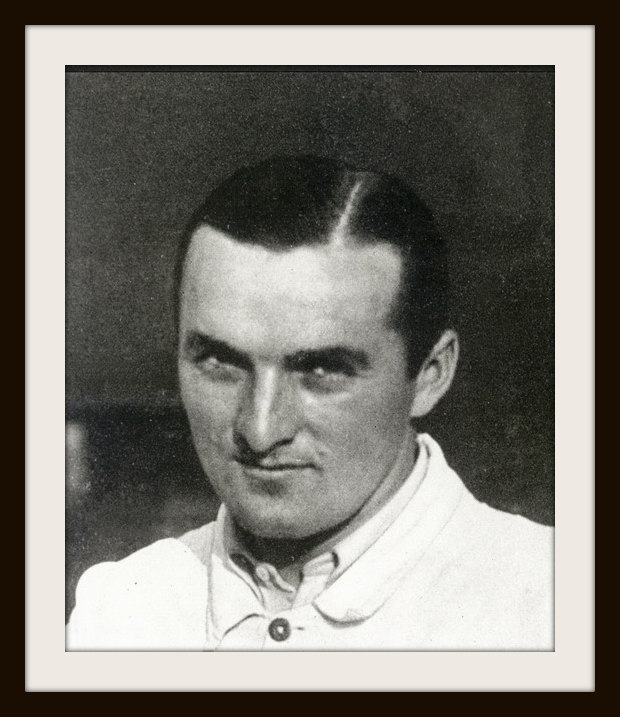
|
|
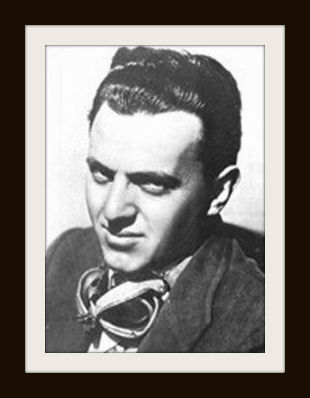
|
EMILIO VILLORESI “Memi Villoresi, l’aquilotto dell’Alfa-Corse”, così titolava “Auto Italiana” del 20 settembre 1938, all’indomani della vittoria di Emilio Villoresi su Alfa Romeo al Gran Premio Milano. Già: perché di Villoresi piloti ce ne furono due, Luigi ed Emilio, fratelli tra di loro. Emilio, minore di un anno, sembra quasi precedere il maggiore come precocità di inclinazione e di risultati. Inizia a correre nel 1933, partecipa alla Mille Miglia, alla corsa in salita dello Stelvio, alla Como-San Maurizio, e continua, con risultati non sfolgoranti, negli anni successivi. Nel 1938 la svolta: viene confermato nel vivaio di piloti - tra cui Nuvolari, Farina, Sommer, Tadini, Pintacuda, Siena, Biondetti e Severi - dell’Alfa Corse, il nuovo organismo sportivo deciso dall’ing. Gobbato all’inizio di quell’anno. Troppe infatti erano le difficoltà derivanti dall’avere l’Alfa Romeo a Milano e la Scuderia Ferrari, ovvero la sua propaggine sportiva, a Modena: e i risultati di gare nel 1937, non certo brillanti per i colori italiani, ne erano la conferma. Così fu decisa la costituzione della nuova società Alfa Corse, indipendente dall’Alfa, ma fisicamente attigua alla fabbrica, con tutti i vantaggi che questa vicinanza comportava (in un mondo senza fax, senza cd-rom, senza internet e videoconferenze). E’ nel 1938 che l’albo d’oro di Emilio Villoresi si arricchisce improvvisamente: è primo assoluto alla XII Parma - Poggio di Berceto, 2° assoluto alla XII Pontedecimo - Giovi, 1° assoluto alla XVIII Coppa Ciano, 1° assoluto al III Gran Premio di Milano. La prima di queste gare segna l’esordio di Wimille unico pilota sull’Alfa Romeo 8 cilindri 2900 cc (il suo debutto infatti era avvenuto con la Mille Miglia sullo stesso modello di vettura, in coppia con Eugenio Siena), ed è anche la sua prima gara nell’Alfa Corse. La sua media non è strabiliante, infatti il record di Tadini dell’edizione precedente resta imbattuto, ma è pur sempre sufficiente per vincere: 114 km/h. Sicuramente con suo grande disappunto, il fratello Gigi, su Lancia Aprilia, arriva soltanto decimo di categoria, nella classe fino a 1500 cc, e nono assoluto. La Pontedecimo-Giovi di quell’anno vede schierati addirittura 57 partecipanti: e tra questi, oltre all’asso già affermato Farina che infatti si porterà a casa il trofeo, viene citato “il giovane acquisto dell’Alfa Corse, Memi Villoresi, concorrente minaccioso vista la sua precedente affermazione”. E difatti arriva secondo, segnando un tempo inferiore di due secondi al primato stabilito nell’edizione precedente, confermando, come scrive la stampa, “le sue ragguardevoli possibilità”. E si arriva a settembre, a Monza. Il Gran Premio d’Italia è preceduto dal Gran Premio Milano per la Coppa del Fascio primogenito. Emilio, su Alfa Romeo naturalmente, è in prima fila con il n. 8; in seconda fila il fratello con il n. 6 su Maserati. Gli altri concorrenti non sono certo da poco: Sommer, Cortese, Castelbarco, Pietsch, Platé. Alla partenza e per i primi giri Emilio e Luigi corrono appaiati, ma al quinto Emilio passa in testa per rimanervi sino alla fine, mentre Gigi è costretto al ritiro per la rottura di un pistone. La marcia delle Alfa Romeo in questa gara è davvero trionfale: tre delle quattro macchine iscritte si classificano, due di esse ai primi due posti con un solo secondo di distacco. E di questo trionfo Emilio è il riconosciuto protagonista. Anche per questo quel suo inspiegabile, fatale incidente nel giugno 1939, in una seduta di prove a Monza, apparve ancora più doloroso. Si parlò di un malore per aver ripreso gli allenamenti troppo a ridosso di un pasto abbondante; di una uscita di pista ad una curva sciaguratamente alberata; del troppo caldo che aveva rallentato i riflessi. In un’intervista rilasciata nel 1989 Luigi ebbe a dire che, venti anni dopo, qualcuno aveva ammesso la rottura dello sterzo. Certo è che fu un colpo tremendo per la famiglia Villoresi, cinque fratelli tutti molto legati tra di loro. Luigi decise che l’unico modo per superare lo choc sarebbe stato ributtarsi a correre subito: e convinse i Maserati, che esitavano, ad iscriverlo ad una gara che si correva quindici giorni dopo. (Donatella Biffignandi. Pubblicato su “Auto d’Epoca”, ottobre 1997) Emilio Villoresi (1914–June 20, 1939) was an Italian Grand Prix motor racing driver. Emilio Villoresi was born in Milan, Lombardy, the younger brother of the star Maserati driver, Luigi Villoresi who co-piloted with him in several races at the beginning of their careers. Emilio Villoresi and his brother competed in the 1935 and 1936 Mille Miglia driving a Fiat 508CS Balilla Sport but after a disappointing finish they purchased a Maserati which they drove individually in different races. Emilio was so successful that he was signed to drive an Alfa Romeo for Scuderia Ferrari in the 1937 season. Nicknamed "Mimì," at the 1937 Coppa Principessa di Piemonte, Emilio Villoresi earned a third place finish behind team-mates Giuseppe Farina and Clemente Biondetti and another third place at the inaugural "Circuito della Superba" at Genoa. In 1938, when the German Silver Arrows were dominating everything in Grand Prix events, Villoresi won the voiturette class at both the Coppa Ciano and the Italian Grand Prix. In May 1939, he finished a strong third to the still dominant Mercedes-Benz cars of Hermann Lang and Rudolf Caracciola but his career was cut short the following month by his death while testing an Alfa Romeo 158 Alfetta for Enzo Ferrari at the Autodromo Nazionale Monza. |